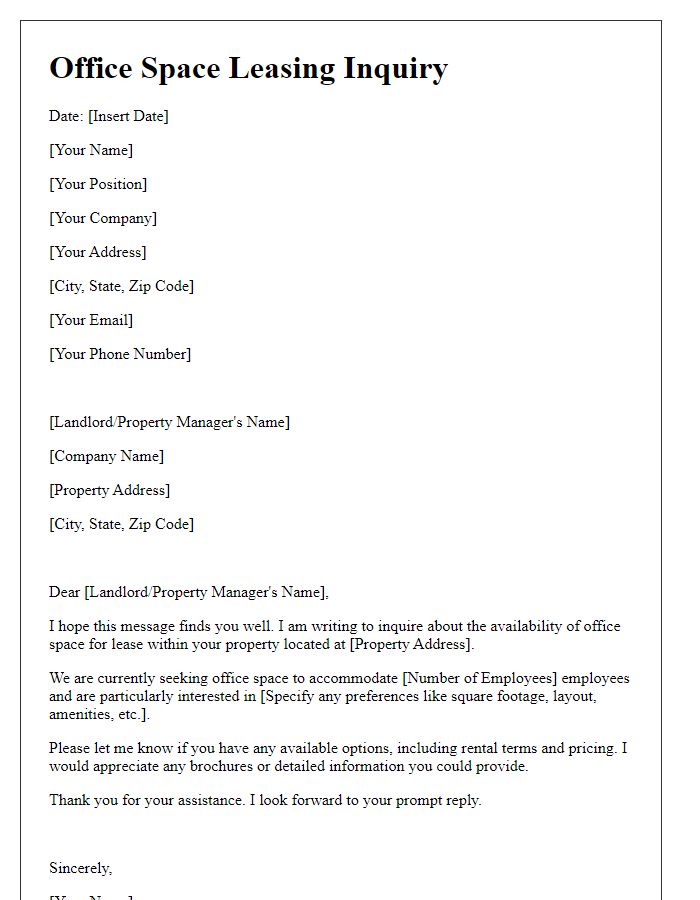Are you considering leasing office space for your business, but unsure where to start? Navigating the world of commercial real estate can be daunting, especially with the multitude of options available. Whether you're a startup looking for a cozy office or a larger company in need of expansive space, understanding the key elements of an effective leasing letter is essential. Let's explore essential tips and a simple template to help streamline your leasing processâread on for more insights!

Clearly defined lease terms and conditions
Office space leasing agreements stipulate specific terms that ensure clarity and mutual understanding for tenants and landlords. The lease duration typically spans between one to five years, with options for renewal or termination clauses defined explicitly. Monthly rental amounts are stated, often adjusted for inflation through predefined indexes such as the Consumer Price Index (CPI). Security deposits, commonly equivalent to one month's rent, safeguard landlords against potential damages. Maintenance responsibilities for common areas, utilities, and janitorial services need clarity, outlining obligations for both parties. The agreement may also address subleasing provisions, allowing tenants to lease the space to another party under agreed conditions. Lastly, permissible alterations to the office space, zoning regulations, and compliance with local building codes ensure the tenant's activities align with municipal laws.
Space specifications and usage flexibility
Office space leasing agreements must outline specific space specifications and usage flexibility to ensure both tenant and landlord understand their obligations. Standard measurements for spaces can range from 1,000 to 10,000 square feet, accommodating different business sizes and types. Key features might include high-speed internet connectivity, meeting rooms with a capacity for 10-20 people, and open floor plans suitable for collaborative work. Usage flexibility allows tenants to reconfigure layouts without significant penalties, fostering adaptability as business needs change. Additionally, zoning regulations in cities such as New York or San Francisco can influence permitted activities within the leased space, ensuring compliance with local laws while providing room for growth.
Financial obligations and payment structures
When leasing office spaces, financial obligations play a critical role in determining both short-term costs and long-term commitments. Typical lease agreements often stipulate monthly rent, which may vary based on location, square footage, and additional amenities offered by the property management (for example, security systems or maintenance services). Security deposits, usually equal to one month's rent, often provide landlords (property owners) with protection against potential damages. Additionally, tenants may encounter unforeseen expenses such as utilities, parking fees (especially in urban areas), and maintenance costs. Some leases may incorporate escalations (annual increases in rent) based on inflation indices, while others may offer a fixed-rate payment structure over the contract term, which typically spans one to five years. Understanding these financial intricacies is vital for effective budgeting and ensuring a successful leasing experience.
Maintenance and repair responsibilities
Office space leasing agreements often outline maintenance and repair responsibilities to ensure the premises remain in good condition. Landlords usually bear the responsibility for structural maintenance, including the foundation, roof, and exterior walls, typically required to uphold safety standards and building codes. Tenants, on the other hand, often handle routine repairs such as minor plumbing issues, electrical work, and cleaning of office spaces. Specific provisions may detail the expectations for reporting issues, timelines for repairs, and conditions under which tenants can request additional maintenance services. Clear delineation of responsibilities is crucial to prevent disputes and maintain a functional working environment.
Termination and renewal options
Office space leasing agreements include critical clauses regarding termination and renewal options, allowing both landlords and tenants to navigate potential changes in occupancy. Notice periods typically vary by contract, often requiring 30 to 90 days' written notice before the lease's end date. Renewal options may offer multiple terms, such as two or five-year extensions, depending on market conditions (like vacancy rates in urban areas). The option to terminate the lease prematurely usually includes penalties or specific conditions, such as a minimum occupancy period or the fulfillment of financial obligations. These provisions are essential for maintaining a flexible business strategy, especially in commercial real estate markets like Manhattan, where demand can shift rapidly. Engaging legal counsel ensures compliance with local laws and lease terms, protecting the interests of both parties involved.













Comments